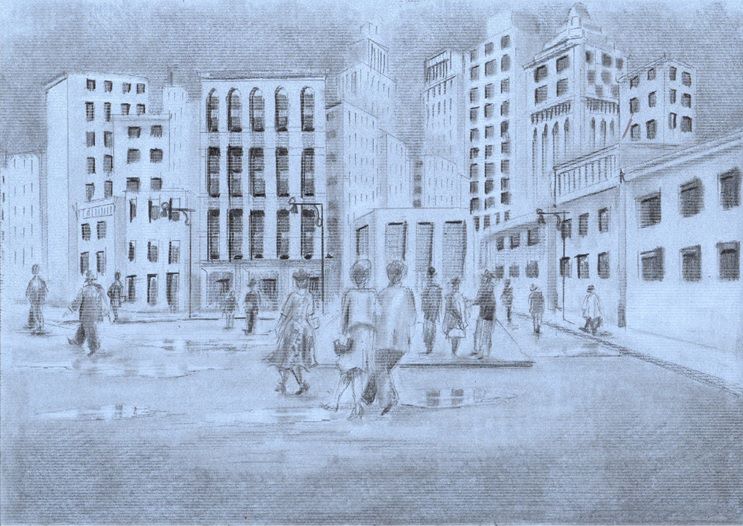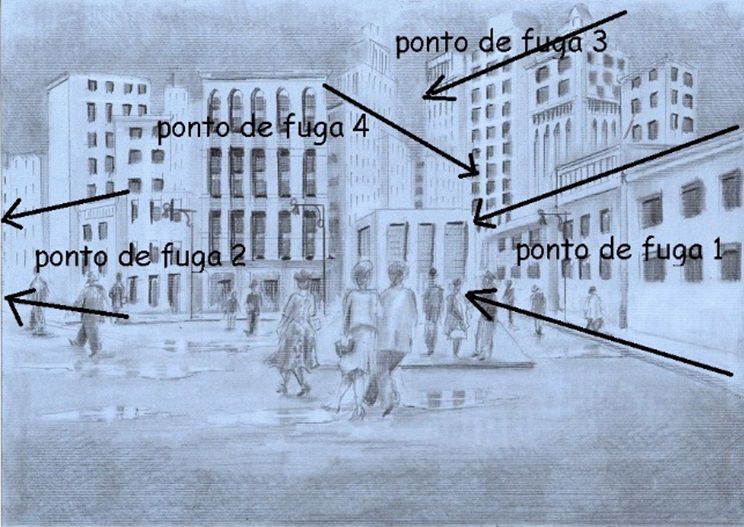
Buildings
The skyscraper rises in fresh air washed by rain
And descends reflected in the mud puddle of the patio
Between reality and image, on the dry ground that separates them,
Four doves stroll.
(BANDEIRA, 2008, p.118)
.
Step by step 13 of how to draw
The rain may alleviate the heat from asphalt. Can she bathe the pavement parched, Gray and lifeless from the street. And it may be that after the storm is an inviting walk program. And ancient times keep reminiscences of a poetic urban, behaved, without the afobações of modernity, without transits prevented, without the violence descomedida. This balanced urban stayed in a remote past, Let your gaps, your saudosismos. And stayed in memory those images of drag of hurried steps, the streets are still empty, the buildings aligned, still clean of graffiti and vandalism cheap that, as a cancer, wealth corrodes, destroys part of culture and history.
This town, beautiful and cozy yet still was in the photographs and in Art and will be drawing today theme. The charm will be for the account of the graphite grey, that reinforces the idea of urban and grace the scene. For this town, people will circulate quietly, without fear and without concerns that steal the urban poetry. For this town (Fig. 1), use textured paper of A4 size; graphite pencil 0,9; 4B pencil or 6B; tortillon, rules and brackets.

As the only art requirement is to have a free spirit, drop your dash and your creativity, Let your pencil do the work, Let him run on the role risk free, uncompromised. Uncomplicate it, your work does not have to be identical to the scene you see, make your interpretation of the world, things that exist, allow your identity image, What is the your image. Just follow the tips of vanishing point and shadows, the rest is due to chance.
The beginning of my work was with the horizontal line, where my scene settled. Tracejei vertical lines of buildings, made with square, for sure that would be parallel and straight in relation to the role. See the video, as I'm in those risks. From there I started the rest of the lines of the buildings and Windows. As well as the drawing of Florence, These buildings are in streets of different positions. Imagine, place the streets in your city and make the buildings satisfy these different vanishing points (Fig. 2). Note that in my drawing, There's a building, whose position is front. In this case, You cannot view your sides, only your front.

When all the buildings are already designed, outline the Windows and doors, following the vanishing points each one of them. Make them following your intuition, your point of view, decorate the buildings with details on your walls. The same should occur with people of the scene. Those are major, those farther away, smaller and less clear to see. Even for people who are close, don't worry about excess details, look for do loose strokes, as if they were in full motion, in the midst of a walk, on the street. Suggest features and details, through loose risks. This is what will make your work a true work of art.
Start painting, always off, down, on paper, starting with the sky. As the scene is after the rain, the sky is still overcast. For this use the pencil or 6B 4B for painting and the stump in light circular movements, to give the appearance of clouds.

The light This scene comes from the top. Adjust the shadows of people and buildings in the opposite direction, where the shadow projects, on the ground. As the sky is still overcast, the shadow cannot be stoned, She must be a bit of a blur. For the pools of water (Fig. 3), do take the irregularly-circulating traits, but not the paint, Neither the skirt too, just be sure to paint the asphalt, These locations. Remember that the water acts as a mirror and reflects all that is above. So do only light reflections of the people and the buildings that are above each pool.
As the work was done with graphite pencil, If you have to, erase with the Pencil Eraser, If it is necessary, sites that need to be more clear. Check and align it with the ruler and set square. And walk through your town, listening to the sounds of old, the buzz of people, looks distracted, or simply feeling the smell of rain on asphalt.
Urban has its secrets and his poems, the artist is enchanted. Your look should be pure like a child. After all, "nothing looks so much like what we call inspiration, as the joy with which the child absorbs the shape and color " (BAUDELAIRE, 2008, p.19). Thus is born the work.
Sign up to receive Event News
and the Universe of Arts first!
Check out the video of the production of the work Buildings:
…
Liked? [highlight]Leave a comment[/highlight]!
You might also like:
- Painting on Canvas, Step by step 18 – Perception of colors and shapes by Rosângela Vig
- Design – Artistic Production, Step by step 17 of how to draw by Rosângela Vig
- Drawing – Painting on Canvas, Step by step 16 of how to draw by Rosângela Vig
- Design – Study of the Form, Step by step 15 of how to draw by Rosângela Vig
- Design – Artistic Production, Step by step 14 of how to draw by Rosângela Vig
- Design – Artistic Production, Step by step 12 of how to draw by Rosângela Vig
- Design – Artistic Production, Step by step 11 of how to draw by Rosângela Vig
- Design – Artistic Production, Step by step 10 of how to draw by Rosângela Vig
- Design – Artistic Production, Step by step 9 of how to draw by Rosângela Vig
- Design – Artistic Production, Step by step 8 of how to draw by Rosângela Vig
- Design – Artistic Production, Step by step 7 of how to draw by Rosângela Vig
- Design – Artistic Production, Step by step 6 of how to draw by Rosângela Vig
- Drawing and Painting – The Abstract, Step by step 5 of how to draw by Rosângela Vig
- Drawing – Movement, Step by step 4 of how to draw by Rosângela Vig
- Drawing – Study of Colors, Step by step 3 of how to draw by Rosângela Vig
- Drawing – Study of Light and Shadow, Step by step 2 of how to draw by Rosângela Vig
- Drawing – Study of Perspective, Step by step 1 of how to draw by Rosângela Vig
Articles about the Art History of Rosângela Vig:
References:
- BANDEIRA, Manuel. Bandeira de Bolso. Porto Alegre: L & PM Pocket, 2008.
- BAUDELAIRE, Charles. On The Modernity. Rio de Janeiro: Editora Paz e Terra, 2007.
The figures:
Fig. 1 – Big old city, Buildings, Rosângela Vig.
Fig. 2 – Great old town with vanishing points, Buildings, Rosângela Vig.
Fig. 3 – Big old city, pools of water, Buildings, Rosângela Vig.
ROSÂNGELA VIG
Sorocaba – São Paulo
Facebook Profile | Facebook Fan Page | Website
Columnist at Website Obras de Arte
E-mail: rosangelavig@hotmail.com
